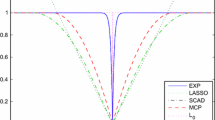Abstract
This paper proposes a two step algorithm for solving a large scale semi-definite logit model, which is appreciated as a powerful model in failure discriminant analysis. This problem has been successfully solved by a cutting plane (outer approximation) algorithm. However, it requires much more computation time than the corresponding linear logit model. A two step algorithm to be proposed in this paper is intended to reduce the amount of computation time by eliminating a certain portion of the data based on the information obtained by solving an associated linear logit model. It will be shown that this algorithm can generate a solution with almost the same quality as the solution obtained by solving the original large scale semi-definite model within a fraction of computation time.
Similar content being viewed by others
References
Aldrich J.H., Nelson F.D. (1984) Linear Probability, Logit and Probit Models. SAGE, Beverly Hills
Galindo J., Tamayo P. (2000) Credit risk assessment using statistical and machine learning: basic methodology and risk modeling applications. Comput. Econ. 15, 107–143
Kelley J.E. (1960) The cutting-plane method for solving convex programs. J. Soc. Indust. Appl. Math. 8, 703–712
Konno H., Gotoh J., Uno T., Yuuki A. (2002) A cutting plane algorithm for semi-Definite programming problems with applications to failure discrimination. In: Pardalos P. et al. (eds) Financial Engineering, E-Commerce and Supply Chain. Kluwer, Dordrecht, pp. 379–396
Konno, H., Kameda, S., Kawadai, N.: Solving a large scale semi-definite logit model. J. Comput. Manage. Sci. (to appear)
Konno H., Kawadai N., Wu D. (2004) Estimation of failure probability using semi-definite programming. J. Comput. Manage. Sci. 1, 59–73
Konno H., Kawadai N., Tuy H. (2004) Cutting plane algorithms for nonlinear semi-definite programming problems with applications. J. Glob. Optim. 25, 141–155
Konno H., Wu D. (2002) Estimation of failure probability using semi-definite programming. (in Japanese). J. SIAM, Jpn. 12, 121–134
Laitinen E.K., Laitinen T. (2000) Bunkruptcy prediction applications of the Taylor’s expansion in logistic regression. Int. Rev. Financ. Anal. 9, 327–349
Shirakawa H. (2001) Credit risk management by scoring. Commun. Oper. Res. Jpn. 46, 628–634
Wolkowitz H., Saigal R., Vandenberghe L. (2000) Handbook of semi-definite programming: theory, algorithm and application. Kluwer, Dordrecht
Author information
Authors and Affiliations
Corresponding author
Rights and permissions
About this article
Cite this article
Konno, H., Kawadai, N. & Shimode, H. A two step algorithm for solving a large scale semi-definite logit model. Optimization Letters 1, 329–340 (2007). https://doi.org/10.1007/s11590-006-0023-4
Received:
Accepted:
Published:
Issue Date:
DOI: https://doi.org/10.1007/s11590-006-0023-4




